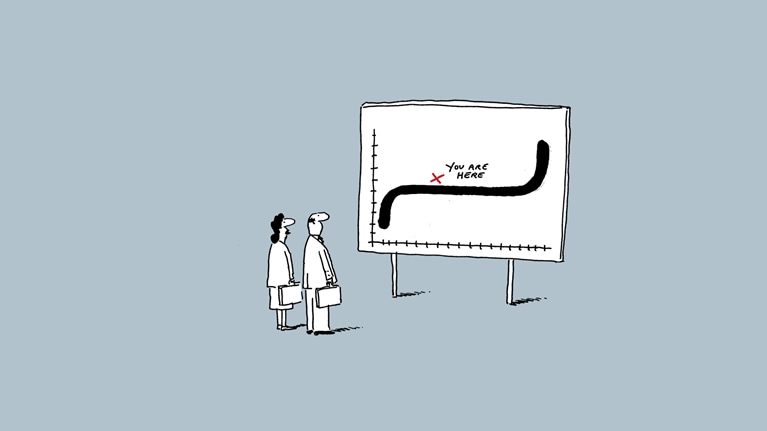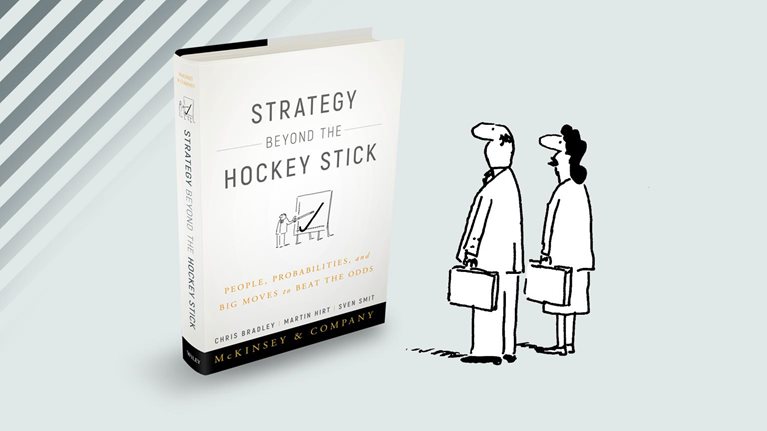Business transformation programs have long focused on productivity improvement—taking a “better, faster, cheaper” approach to how the company works. And for good reason: disciplined efforts can boost productivity as well as accountability, transparency, execution, and the pace of decision making. When it comes to delivering fast results to the bottom line, it’s a proven recipe that works.
The problem is, it’s no longer enough. Digitization, advanced technologies, and other forms of tech-enabled disruption are upending industry after industry, pressuring incumbent companies not only to scratch out stronger financial returns but also to remake who and what they are as organizations.
Doing the first is hard enough. Tackling the second—changing what your company is and does—requires understanding where the value is shifting in your industry (and in others), spotting opportunities in the inflection points, and taking purposeful actions to seize them. The prospect of doing both jobs at once is sobering.
How realistic is it to think your company can pull it off? The good news is that our research demonstrates it’s entirely possible for organizations to ramp up their bottom-line performance even as they secure game-changing portfolio wins that redefine what a company is and does. What’s more, “all-in” transformations that focus on the organization’s performance and portfolio appear to load the dice in favor of transformational results. By developing these two complementary sets of muscles, companies can aspire to flex them in a coordinated way, using performance improvements to carry them to the next set of portfolio moves, which in turn creates momentum propelling the company to the next level.
Life on the power curve
If you want to see where you’re going, it’s best to start with a point of reference. Our choice, the power curve of economic profit, came out of a multiyear research effort that sought to establish empirical benchmarks for what really makes for success in strategy. To create Exhibit 1, we plotted the economic profit (the total profit after subtracting the cost of capital) earned by the world’s 2,393 largest nonfinancial companies from 2010 to 2014. The result shows a power curve that is extremely steep at both ends and flat in the middle. The average company in the middle three quintiles earned less than $50 million in economic profit. Meanwhile, those in the top quintile earned 30 times more than the average firm in our sample, capturing nearly 90 percent of all the economic profit created, or an average of $1.4 billion annually.

Although there is an enormous gulf between the middle firms and the top-quintile firms, companies can and do move up. Eight percent, or one in 12 companies, managed this feat across the decade we examined (from a starting position in 2000–04, to an ending position of 2010–14). As described in Strategy Beyond the Hockey Stick (Wiley, 2018), the specific odds of a company succeeding are largely explained by its endowment (for example, its size and debt capacity), its trends (a declining or improving industry), and the application of five big moves.
While all of these factors matter, the five moves play the biggest role in determining whether or not a company successfully climbed the power curve. They are also the ingredients of a truly transformational transformation program, so let’s look at them next.
Big moves in the transformation tool kit
To place the five big moves in the context of transformation, we divided them into two categories. The first covers “performance-related” moves. These include substantial changes that lead to better margins and potential new fit-for-purpose business models.
Productivity improvements are a management favorite in the performance genre, but to qualify as a big move, the relative improvement versus your sector must outpace 70 percent of firms over a decade.
Differentiation improvement is the other performance-related move, covering innovation in products, services, and business models. Similarly, for this move to really transform the business, we said that your company’s gross margin improvement must put it in the top 30 percent of its industry’s improvement—or, to put another way, you must deliver 25 percent more improvement than your industry median.

The second category covers three “portfolio-related” moves. The first is active resource reallocation, which we define as the company shifting more than 60 percent of its capital spending across its businesses or markets over ten years. Such firms create 50 percent more value than counterparts that shift resources at a slower clip.1 Meanwhile, a big move in programmatic M&A—the type of deal making that produces more reliable performance boosts than any other—requires the company to execute at least one deal per year, cumulatively amounting to more than 30 percent of a company’s market capitalization over ten years, and with no single deal being more than 30 percent of its market capitalization. Finally, for capital programs to qualify as a big move, the ratio of capital expenditure (capex) to sales must exceed 1.7 times the industry median for at least a decade.
While the five moves are by definition big relative to competitors, this does not mean they are brash or reckless. In fact, making big moves tends to reduce the risk profile and adds more upside than downside (although how much of each depends in part on your industry’s trends, as we will see). The way we explain this to senior executives is that when you’re parked on the side of a volcano, staying put is your riskiest move. Moreover, the five moves are cumulatively big and are most effective when combined in carefully considered ways. The successful big movers rarely lurch; they are far more likely to move consistently and steadily, with a constancy of purpose, over a long period of time.
Combining moves to transform
As shown in Strategy Beyond the Hockey Stick, for companies in the middle ranks of the power curve, making one or two of the five big moves increases a company’s odds of rising into the top quintile from 8 percent to 17 percent; making three big moves boosts these odds to nearly 50 percent. In our latest research, we sought to become more granular about the relationship between different categories of moves, by segmenting 1,435 companies that started in the middle three quintiles of the power curve into four transformation “stories” (Exhibit 2). Those relationships are interesting in their own right, and we also hope they will help leaders raise their sights in a nuanced way. Resetting aspirations often represents a critical need. It’s quite rare for companies to make more than a single big move; about 80 percent of our sample made exactly one move, or none at all.

Static
The largest group, representing 47 percent of the companies we studied, didn’t make any of the five big moves. This doesn’t mean they didn’t make plans or moves—only that their moves weren’t big enough to reach our bar for transformational results. The members of this “static” group had the lowest odds of reaching the top quintile of the power curve, at 4 percent.
Performance only
Twenty-six percent of the companies made at least one big, performance-oriented move, but no portfolio moves. As a result, they nearly doubled their odds of rising to the top quintile of the power curve.
Portfolio only
Meanwhile, 15 percent of the companies we studied made a major move that reshaped their portfolio, but they didn’t make big moves in productivity or differentiation. At 11 percent, they had an even better chance than the performance-only group of vaulting to the top quintile. For example, Tele2, a Sweden-based telecom, used a strong programmatic-M&A strategy, featuring 16 acquisitions during the period we studied (2000 to 2012), to gradually expand to new markets while using the infrastructure from its acquisitions to strengthen its product offering.
All in
The 12 percent of companies in our sample that made at least one big move in both categories were rewarded with the highest odds of climbing the power curve, at 22 percent. Consider the case of Sun Pharmaceutical, an India-based manufacturer of generic drugs, which made clear differentiation improvements and executed a strong capital program over the period we studied. This allowed the company to seize upon the industry trend of increased local and global demand for generic medicines. In 2007, the company divested its research arm to focus fully on generics. This resulted in an aggressive expansion of the company’s production capacity (with a capital-expenditure ratio twice as high as the industry median at that time) and a strong focus on higher-margin generics (its gross margin doubled between 2000 and 2014).
The implication of these transformation stories is clear: approaches that go all in by addressing both a company’s performance and its portfolio yield the highest odds of lasting improvement. Over the course of a decade, companies that followed this path nearly tripled their likelihood of reaching the top quintile of the power curve relative to the average company in the middle three tiers.2
Play to your industry context
Life would be simpler if our story ended here. However, you’re not operating in a competitive vacuum. As we described earlier, other forces influence your odds of success in significant ways—in particular, how your industry is performing. To map this effect, we divided our sample of companies according to whether or not their industry improved its average economic profit over the decade we studied. We knew from our previous research that companies facing competitive headwinds would face longer odds of success than those with tailwinds, but what we now saw was the extent to which the impact of different combinations of moves affected the odds for each group.
Running against the wind
Among the companies in the power curve’s middle three quintiles, fully 60 percent compete in industries where the average economic profit is declining. Life is tough with a headwind, and these companies must run hard just to stand still. Just how hard becomes clear when we look at their net odds of success. We calculated this by netting their chances of moving to the top quintile against their chances of falling to the bottom quintile.
The net odds say it all: companies in declining industries have a 4 percent chance of moving up the power curve, but an 18 percent chance of moving down (meaning their net odds are negative 14 percent). If you’re in this group, how you employ the five big moves says a lot about how you’re likely to fare (Exhibit 3). Among our findings:
- Standing still is a terrible idea. The odds associated with a static approach are grim, equating to a 2 percent chance of reaching the top of the power curve and a 16 percent chance of slipping to the bottom. Nonetheless, just over half the companies in declining industries followed this path.
- Good performance alone won’t cut it. Surprisingly, perhaps, we found that performance-only moves also equate to negative net odds. True, the downside risk is lower with this approach than if you make no big moves at all—but not by much. This finding flies against the conventional wisdom that the best response in a declining industry is corporate belt tightening.
- You can’t spend your way out of trouble. Companies taking a capex-only approach added far more downside than upside. Why? Big capital expenditures are an amplifier, pushing you faster in a good direction if the underlying investment is smart, and faster in a bad direction if it’s not. Given the added drag of an industry headwind, a capex-only approach to transformation is like stepping on the accelerator in heavy traffic: you won’t get far and may well crash.3
- All in is your best chance. Companies that combined big performance moves with big portfolio moves (including capital expenditures, when not the only portfolio move employed) saw a big lift in their odds. Life is still challenging for these companies—their net odds are dead even—yet this is superior to the negative odds of the other situations. Ultimately, a bit more than one in five companies in this category were able to move to the top quintile.

Riding on the wind
The other 40 percent of the companies in the middle three quintiles have it much better, having been gifted a positive economic trend. For these organizations, the chances of success are enhanced: 15 percent, on average, rise to the top of the power curve, and just 8 percent fall to the bottom. For this group, too, the application of the big moves affected the outcome (Exhibit 4). Among the implications:
- Don’t waste your gifts. A static approach is still a bad idea. While the odds of moving up the power curve were 9 percent for companies in this situation, the odds of moving down were 7 percent. You can do better.
- Press your performance advantage. In an improving industry, the returns to performance improvement are amplified massively. This runs contrary to the very human tendency of equating performance transformations with turnaround cases. If you are lucky enough to enjoy an industry tailwind, a performance-only transformation raises your upside odds to 15 percent and lowers your downside chances to just 2 percent. When in the fast lane, step on the gas.
- Don’t spend big without better performance. Far from being oil and water, growth and productivity improvement are well paired. Nonetheless, be wary of big capital-expenditure programs that don’t improve the overall cost and gross-margin economics of the business. Your net odds of success are much worse in this scenario than if you made no big moves at all. Combining a big capital-expenditure move with a big performance move, however, gives you net odds that are more than seven times better than standing pat.
- All in wins again. Indeed, the all-in approach to transformation wins out. Depending on their particular combination of portfolio and performance moves, organizations in this category saw their chances of entering the top quintile reach a whopping 39 percent, versus a 6 percent chance of slipping down.

The takeaway from all this is that two big rules stand out as commonly and powerfully true whatever your context: first, get moving, don’t be static; second, go all in if you can—it’s always the best outcome (and also the rarest).
Getting to all in
In our experience, the companies that are most successful at transforming themselves sequence their moves so that the rapid lift of performance improvement provides oxygen and confidence for big moves in M&A, capital investment, and resource reallocation. And when the right portfolio moves aren’t immediately available or aren’t clear, the improved performance helps buy a company time until the strategy can catch up.
To illustrate this point, consider the anecdote about Apple that UCLA business professor Richard Rumelt describes in his book, Good Strategy/Bad Strategy (Crown Publishing, 2011). It was the late 1990s; Steve Jobs had returned to Apple and cleaned house through productivity-improving cutbacks and a radically simplified product line. Apple was much stronger, yet it remained a niche player in its industry. When Rumelt asked Jobs how he planned to address this fact, “[Jobs] just smiled and said, ‘I am going to wait for the next big thing.’”
While no one can guarantee that your “next big thing” will be an iPod-size breakthrough, there’s nothing stopping you from laying the groundwork for a successful all-in transformation. To see how prepared you are for such an undertaking, ask yourself—and your team—the following six questions. We hope they provoke productive and, dare we suggest, transformative discussion among your team.
Where is the value flowing, and what can we do about it?
Achieving success with big, portfolio-related moves requires understanding where the value flows in your business and why. The structural attractiveness of markets, and your position in them, can and does change over time. Ignore this and you might be shifting deck chairs on the Titanic. Meanwhile, to put this thinking into action, you must also view the company as an ever-changing portfolio. This represents a sea change for managers who are used to plodding, once-a-year strategy sessions that are more focused on “getting to yes” and on protecting turf than on debating real alternatives.
For more about how to transform the dynamics in your strategy room, see “Eight shifts that will take your strategy into high gear.”
Do we put our money where our strategy is?
About one-third of US companies reallocate no more than 1 percent of their resources from year to year. Whether through bias, office politics, or plain old inertia, they simply roll this year’s plan into next year. It should, by now, go without saying that this is a terrible starting position from which to expect transformative change. Companies can escape the cycle by creating target portfolios, adopting decision rules, and creating simple processes to break free of inertia.
For more, see “How to put your money where your strategy is.”
Are we ready for cannibalism?
Increasingly, incumbent organizations are getting to the pointy end of disruption, where they must accelerate the transition from legacy business models to new ones and even allow potentially cannibalizing businesses to flourish. Sometimes this requires a very deliberate two-speed approach where legacy assets are managed for cash while new businesses are nurtured for growth.
For more on embracing such a mind-set, see the Harvard Business Review article “The best companies aren’t afraid to replace their most profitable products,” on hbr.org.
Are we aiming high enough?
Bold aspirations matter hugely in business transformation, but people tend to be far more comfortable when they “underpromise and overdeliver.” The upshot, in our experience, can be setting initial targets (for example, in securing performance-related improvements) that are two or even three times lower than they could be over time.
For more on how to set strong aspirations and, more importantly, how to evolve them, see “The numbers behind successful transformations,” forthcoming on McKinsey.com, and “Transformation with a capital T.”
Will our company take this seriously?
Embracing transformative change requires commitment, and gaining commitment requires a compelling change story that everyone in the company can embrace. Philips recognized this in 2011 when it launched its “Accelerate!” program. Along with productivity improvements and portfolio changes (including a big pivot from electronics to health tech), the company shaped its change story around improving three billion lives annually by 2030, as part of a broader goal of “mak[ing] the world healthier and more sustainable through innovation.”
For more about what works—and what doesn’t—in creating a change story, see “The irrational side of change management.”
Are you up to the leadership challenge?
Leading a successful transformation requires a lot more than just picking the right moves and seeing them through. Among your other priorities: build momentum, engage your workforce, and make the change personal for yourself and your company. All of this means developing new leadership skills and ways of working, while embracing a level of commitment as a leader that may be unprecedented for you.
For more on addressing these challenges, see “The wisdom of transformations: How successful CEOs think about change.”


